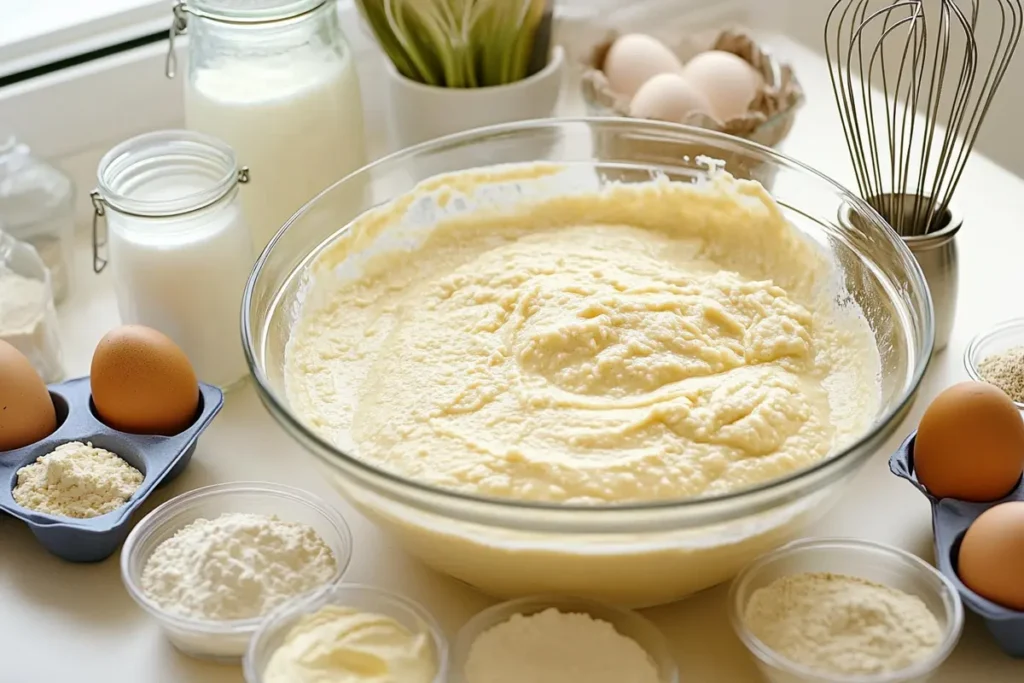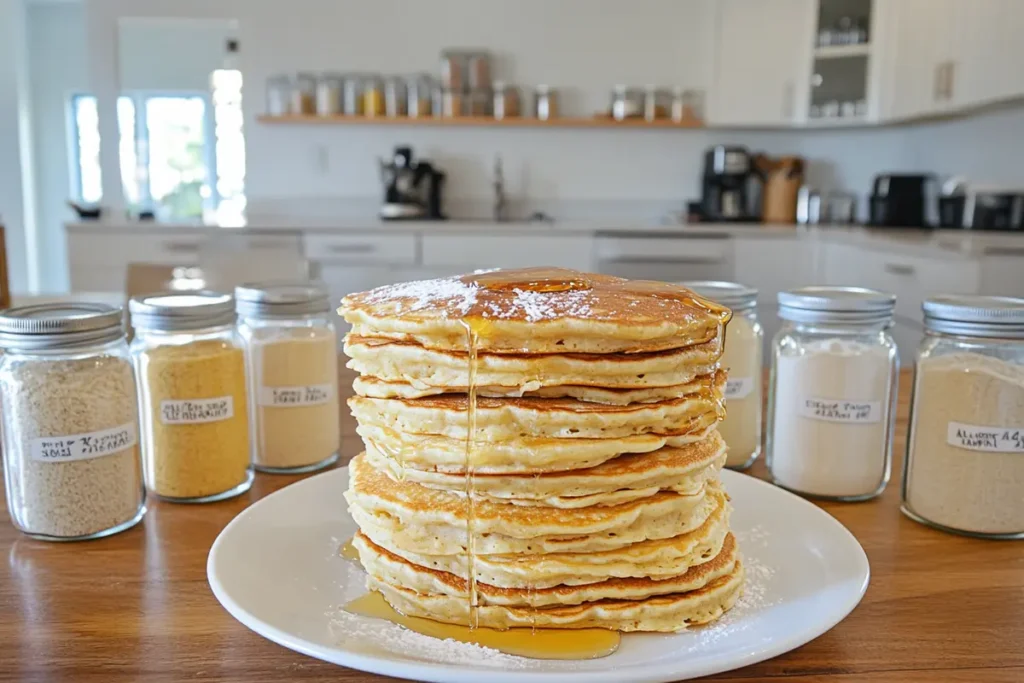Pancakes are a universal favorite, but the choice of flour can make or break your recipe. Whether you’re aiming for fluffy American-style pancakes, delicate crêpes, or hearty whole-grain stacks, choosing the best flour is essential. In this article, we’ll explore the various types of flour and help you find the perfect one for making pancakes tailored to your taste and dietary needs.

Introduction to Pancake Flour
The question “What is the best flour for making pancakes?” might seem simple, but the answer depends on several factors: the type of pancakes you prefer, the desired texture, and any dietary restrictions you might have. Flour is the base of any pancake batter, and its type, protein content, and grind can drastically affect the outcome.
Types of Flour for Pancakes
Let’s break down the most popular types of flour used in pancakes and how they influence texture, flavor, and cooking:
1. All-Purpose Flour
Why it’s popular:
All-purpose flour (AP flour) is the most commonly used flour for pancakes. It’s versatile, easy to find, and provides consistent results. With a moderate protein content of 10-12%, it strikes a balance between structure and tenderness, making it perfect for fluffy pancakes.
Best for:
- Classic American pancakes
- Buttermilk pancakes
Tips for using AP flour:
- Sift the flour for extra-light pancakes.
- Combine with baking powder or baking soda for leavening.
2. Whole Wheat Flour
Why it’s healthy:
Whole wheat flour retains the bran and germ of the wheat kernel, making it a nutrient-dense choice. It has a nuttier flavor and higher fiber content compared to all-purpose flour, making your pancakes heartier and more filling.
Best for:
- Healthy, fiber-rich pancakes
- Nutty, whole-grain pancakes
Tips for using whole wheat flour:
- Mix it with AP flour in a 50:50 ratio for a balance between nutrition and fluffiness.
- Add extra liquid to the batter since whole wheat flour absorbs more moisture.
3. Self-Rising Flour
Convenience in a bag:
Self-rising flour is pre-mixed with baking powder and salt, saving you time when preparing your pancake batter. It ensures even leavening, resulting in light and fluffy pancakes.
Best for:
- Quick, easy pancake recipes
- Beginner cooks
Tips for using self-rising flour:
- Skip adding extra leavening agents like baking powder.
- Adjust the salt in your recipe to account for the salt in the flour.
4. Almond Flour
Gluten-free goodness:
Almond flour is made from finely ground blanched almonds. It’s naturally gluten-free and has a slightly sweet, nutty flavor. Almond flour pancakes are moist and tender, though they don’t rise as much as those made with traditional flours.
Best for:
- Gluten-free or grain-free diets
- Low-carb pancakes
Tips for using almond flour:
- Pair it with eggs or xanthan gum for better structure.
- Cook on low heat to prevent burning.
5. Oat Flour
A healthy twist:
Oat flour is made from finely ground oats and has a mild, slightly sweet flavor. It’s gluten-free (if certified) and packed with fiber and nutrients. Oat flour pancakes are soft and hearty, making them a great choice for health-conscious eaters.
Best for:
- Gluten-free and high-fiber pancakes
- Kids’ pancakes (easy on the digestive system)
Tips for using oat flour:
- Blend rolled oats in a food processor to make your own oat flour.
- Add a binding agent like eggs or bananas to hold the batter together.
6. Buckwheat Flour
Earthy and unique:
Despite its name, buckwheat isn’t related to wheat and is naturally gluten-free. Buckwheat flour has an earthy, slightly bitter flavor that works well in traditional recipes like French crêpes or Russian blinis.
Best for:
- Gluten-free diets
- Savory pancakes or crêpes
Tips for using buckwheat flour:
- Combine with another flour for a lighter texture.
- Sweeten the batter to balance the flour’s natural bitterness.
7. Cake Flour
The ultimate fluffiness:
Cake flour has a lower protein content (6-8%) than all-purpose flour, resulting in extra-tender and fluffy pancakes. Its fine texture ensures smooth, lump-free batter.
Best for:
- Extra-light, fluffy pancakes
- Delicate dessert pancakes
Tips for using cake flour:
- Sift the flour for an ultra-light batter.
- Avoid overmixing, as the low protein content doesn’t need much gluten development.
8. Gluten-Free All-Purpose Flour
For dietary needs:
This blend of gluten-free flours, starches, and xanthan gum mimics the properties of regular flour. It’s a lifesaver for those with gluten sensitivities or celiac disease.
Best for:
- Gluten-free classic pancakes
- Allergy-friendly recipes
Tips for using gluten-free AP flour:
- Let the batter rest for 5-10 minutes to hydrate and thicken.
- Follow the package instructions for optimal results.
How to Choose the Best Flour for Your Pancakes
Consider Your Texture Preference
- Fluffy Pancakes: All-purpose or cake flour works best.
- Hearty Pancakes: Whole wheat or buckwheat flour adds texture and flavor.
- Moist Pancakes: Almond flour or oat flour creates tender results.
Think About Dietary Needs
- Gluten-Free: Opt for almond flour, oat flour, or gluten-free all-purpose flour.
- Low-Carb: Almond or coconut flour are excellent choices.
- High-Fiber: Whole wheat or oat flour offers the best nutritional boost.
Experiment with Blends
Mixing flours can give you the best of both worlds. For example:
- Combine whole wheat flour with all-purpose flour for balanced flavor and texture.
- Blend almond flour with oat flour for a moist, gluten-free batter.
Tips for Perfect Pancakes Regardless of Flour

- Measure Precisely: Use a kitchen scale for accurate measurements.
- Don’t Overmix: Overmixing creates tough pancakes. Stir until just combined.
- Use Fresh Ingredients: Fresh baking powder and high-quality flour yield better pancakes.
- Rest the Batter: Let the batter sit for 5-10 minutes to hydrate the flour and ensure even cooking.
- Cook at the Right Temperature: Medium heat prevents burning and ensures thorough cooking.
Flour Comparisons for Pancakes
| Flour Type | Protein Content | Best For | Texture |
|---|---|---|---|
| All-Purpose Flour | 10-12% | Classic pancakes | Balanced fluffiness |
| Whole Wheat Flour | 13-14% | Healthy pancakes | Nutty, hearty |
| Self-Rising Flour | 9-11% | Quick pancakes | Light, fluffy |
| Almond Flour | ~6% | Gluten-free, low-carb | Moist, tender |
| Oat Flour | ~7% | Gluten-free, high-fiber | Soft, hearty |
| Buckwheat Flour | 12-15% | Gluten-free, savory pancakes | Earthy, dense |
| Cake Flour | 6-8% | Ultra-light pancakes | Delicate, airy |
Frequently Asked Questions
1. Can I use bread flour for pancakes?
Bread flour is high in protein (12-14%), which makes pancakes dense and chewy. While it’s not ideal, you can mix it with lower-protein flours to soften the texture.
2. How do I make gluten-free pancakes?
Use almond, oat, or gluten-free all-purpose flour. Add a binding agent like eggs or xanthan gum for structure.
3. Can I substitute whole wheat flour for all-purpose flour?
Yes, but whole wheat flour absorbs more liquid, so you’ll need to adjust by adding extra milk or water.
4. What’s the best flour for fluffy pancakes?
Cake flour or sifted all-purpose flour produces the fluffiest pancakes.
5. Can I mix different flours for pancakes?
Absolutely! Combining flours lets you customize texture and flavor to your liking.
Conclusion: Finding Your Perfect Pancake Flour
What is the best flour for making pancakes? It depends on your preferences and dietary needs. All-purpose flour is a reliable choice for most, but experimenting with whole wheat, almond, or oat flour can lead to exciting new flavors and textures. With the right flour and a few simple techniques, you can create pancakes that are perfect every time.